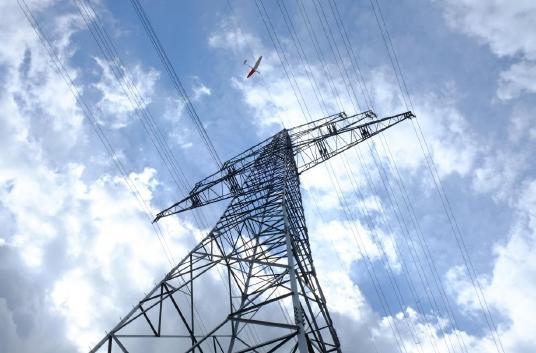Elia tests first drone for long-distance flight
Drones for inspecting Belgium's high-voltage grid
Deploying drones as 'eyes in the sky' has a number of key advantages: the current running through the high-voltage line does not need to be switched off, the inspection takes less time, and the inspector remains safe on the ground. After an incident, such as a storm, Elia can more quickly ascertain whether any damage has been caused.
Elia has already conducted tests deploying multicopter drones for local inspection flights. Now it is the turn of long-distance flights involving fixed-wing drones. Elia's current policy on inspections provides for regular checks on foot, by car or by helicopter. This way the grid operator verifies whether pylons and electrical equipment are still in an acceptable state or condition and if the distance to vegetation remains sufficient. Elia is busily preparing for the structural deployment of drones. To this end, four pilots have already been trained internally, and four more Elia employees have started training as pilots.
Belgium has had a legal framework in place since May 2016 that permits the deployment of drones. However, flights remain limited to staying within the pilot's field of vision. In other European countries, such as France, drones may already carry out long-distance flights. The European framework is currently being developed and the public consultation procedure is ongoing. Elia is looking forward to a speedy development of the Belgian legal framework for long-distance flights. This test flight already marks a step in the right direction.
Results of demo flight to help define legal framework
This first long-distance demo flight proves that this type of drone is both reliable and safe. The organisation was taken care of by the French drone company Delair. The full results of the test flight will be submitted to FPS Mobility's Directorate-General for Aviation (DGTA/DGLV) which can use the data to help devise the legal framework.
“Delair is one of the world’s most experienced providers of industrial drone solutions, with a track record of successful long distance drone operations while controlling our drones via a 3G cellular network,” explains Peter Cosyn from Delair. “We are delighted to perform this test flight with Elia, confirming that renowned enterprises are committed to adopt drone solutions to improve business efficiencies through aerial-based data collection and analysis.”
Peter Dedrij, Droneport: "Droneport is the platform for testing and demonstrating new drone applications. This long-distance flight is certainly an important step in this connection".
Michiel Uwaerts, Elia's Drones Project Leader: "Our job is to manage and maintain the Belgian high-voltage grid as effectively as possible to keep it in excellent condition. New technologies like drones can certainly help to do this even more safely and efficiently, which can only be good for ensuring the grid's reliability".

Characteristics of the drone used for long-distance flights:
Drone Delair DT18:
- Maximum flight duration = 120 mins
- Weight = 2 kg
- Wingspan = 1.8 m
- Maximum range = 100 km
Drone Delair DT26X:
- Maximum flight duration = 135 mins
- Weight = 18 kg
- Wingspan = 3.3 m
- Maximum distance = 150 km
- Source:
- Elia
- Author:
- Press Office
- Link:
- www.elia.be/...
- Keywords:
- Belgium, grid operator, drone, inspection, legal framework


























